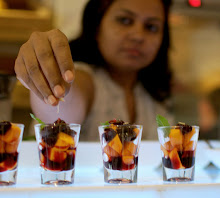Murgh ki tahiri or chicken tahiri is one of the comfort foods we love, sometimes more than Biryani because of the simpler flavours and the fact that the chicken tahiri is more moist than a chicken biryani.
One pot meals are a norm on my table. I love such meals because one gets the comfort of a good meal in just one dish, not much because it involves lesser work in the kitchen but the taste and warm comfort such meal bring. Our tahiris and khichdis are not so simple to cook as they sound most of the times but we love such meals for many reasons other than that.
In fact if you think of it, most one pot meals involves as much work as any other meal if you are including all major nutrient groups in one pot, especially the vegetables. You do all the chopping, you do some sauteing, tempering and whatever needed, only the ingredients are cooked in one pot. And most of the times our tahiris and khichdis are served with an appropriate raita that needs additional work but no one minds that.
ingredients
(2 servings and may be some leftover)
2 legs of chicken cut in 3 pieces each
1/4 cup of rice
1 cup of fine diced onions
1/2 cup of chopped coriander leaves (dhaniya patta) along with the stems
1/2 cup of finely chopped fenugreek (methi) leaves or a handful of crushed dry kasoori methi (optional)
1 tbsp minced ginger
1 tsp minced garlic
chopped green chilies as per taste
everyday curry powder 1 tbsp
special garam masala 1/2 tsp
turmeric powder 1/2 tsp or lesser
salt to taste
2 tbsp ghee
1 tsp cumin seeds
2-3 tejpatta (Indian bay leaves)
1 tsp lemon juice mixed with 1/4 cup water
procedure
Rinse the rice, drain water and keep for 10-15 minutes till you proceed with the chicken and spices.
Heat ghee in a thick base handi or stockpot. Add the cumin seeds and wait till it gets fried and aromatic. Tip in the onion, ginger and garlic and fry on low heat till it starts getting pinkish brown.
Add the fenugreek leaves or crushed dry kasoori methi if using and the chicken pieces. Keep bhunoeing (sauteing) for about 5 minutes on medium heat. Add the powder spices and salt, stir and cook some more till the spices become aromatic and the chicken looks a little glazed. Add the chopped dhaniya patta and stir to mix.
Now add a cup of water and let the chicken cook covered for 10 minutes. Heat a griddle on the other side of gas stove in the meanwhile.
Add the rice and the lemon juice mixed with water, mix well and cover the pot tightly. Place the hot griddle under the tahiri pot and let it cook on very low flame for 10-12 minutes. Switch off the flame and let the pot sit for another 10 minutes before you open and serve the chicken tahiri steaming hot.
It tastes best with raw onion and pomegranate raita but you can make cucumber raita or any other raita you like. We like it even with a kachumber salad of tomatoes and onions and may be some flame roasted papad too. In fact the chicken tahiri can have many side dishes on the table, have it as simple as you wish or make it elaborate with as many side dishes you wish to have with it.
Chicken tahiri or murgh tahiri will never fail to comfort you warmly and softly like a grandmother. Trust me.
We had it for dinner last month sometime between our back to back travels and the pictures were taken in a hurry to document it. Otherwise I have rarely been able to click pictures of our tahiri meals although we have tahiri quite often.





























